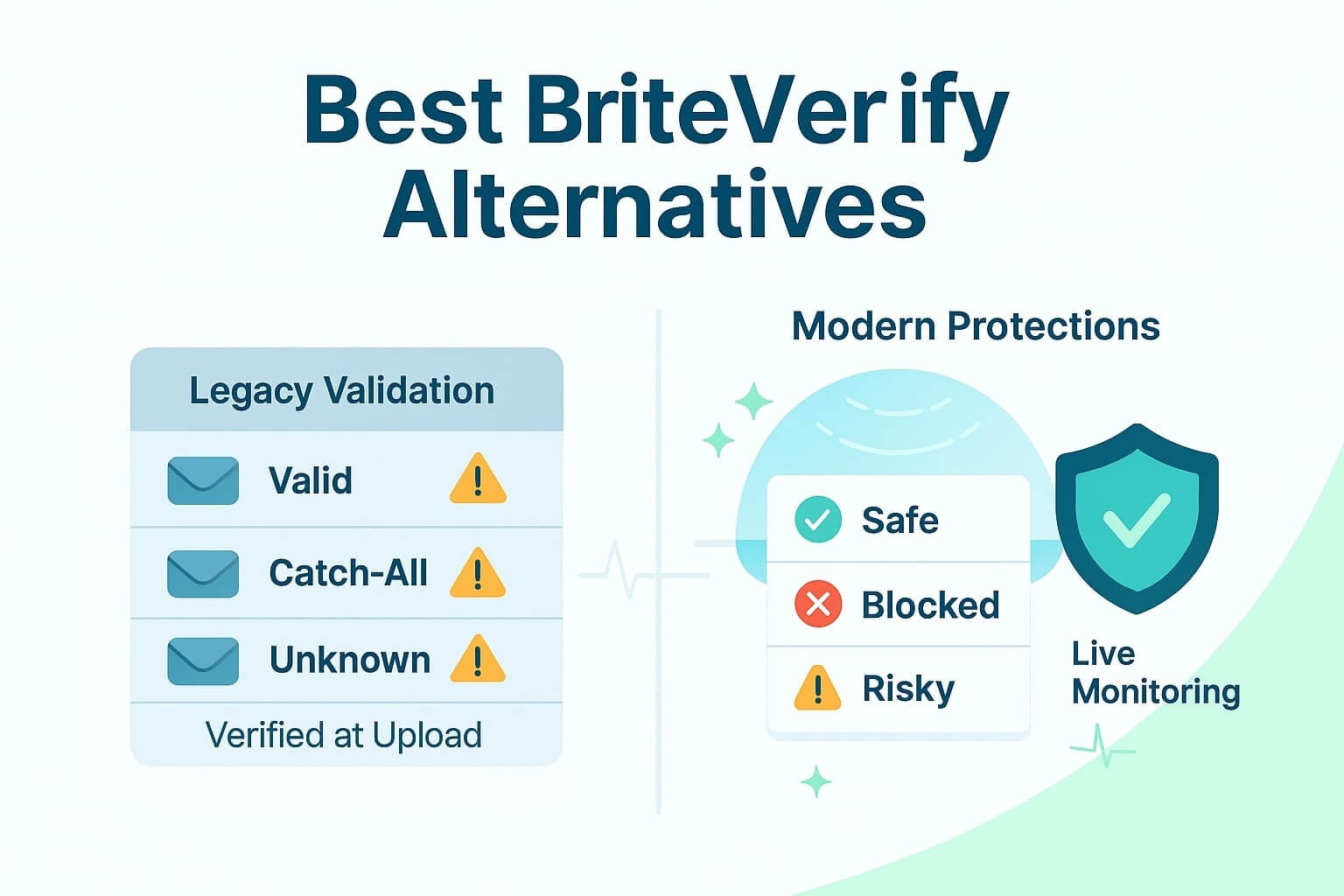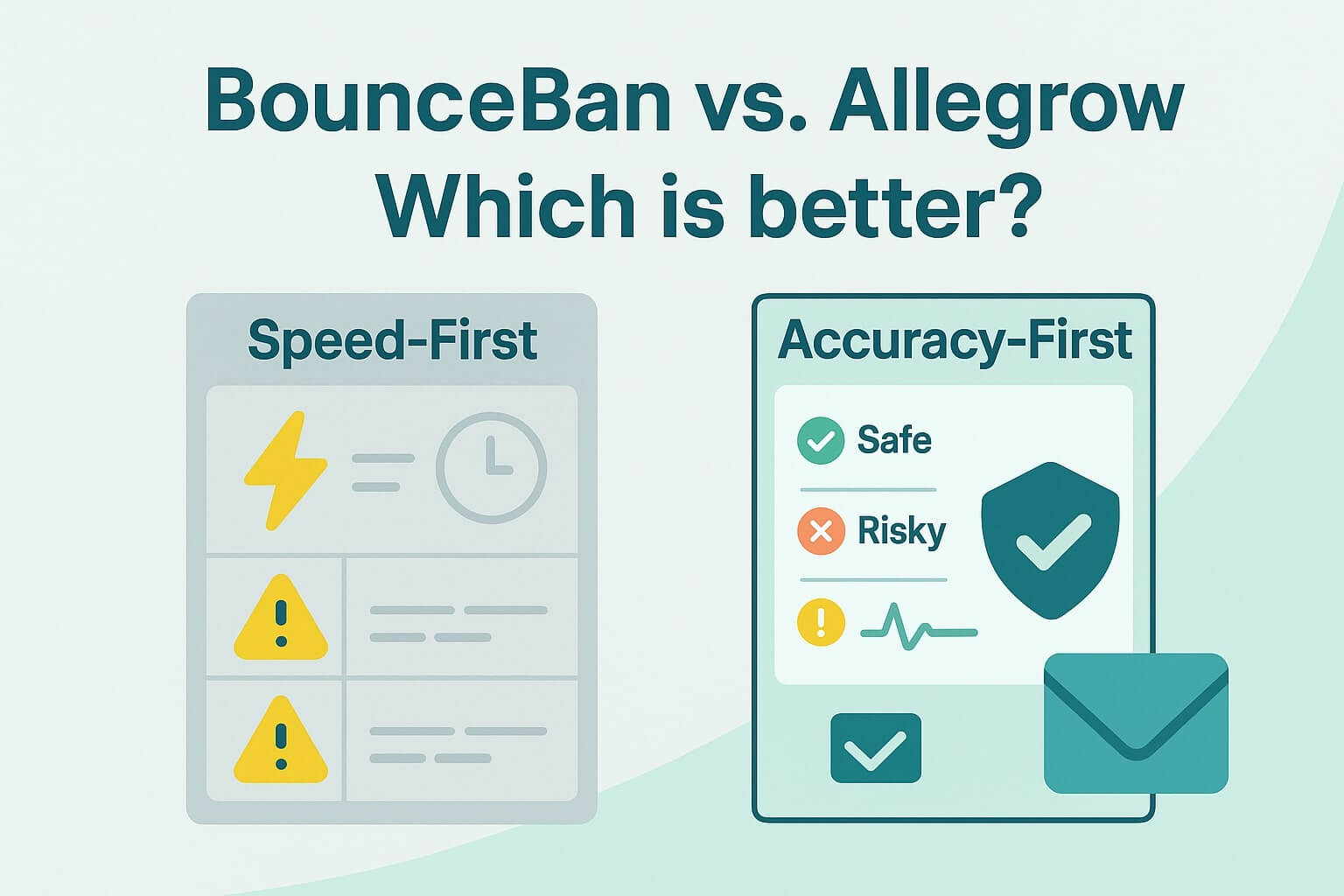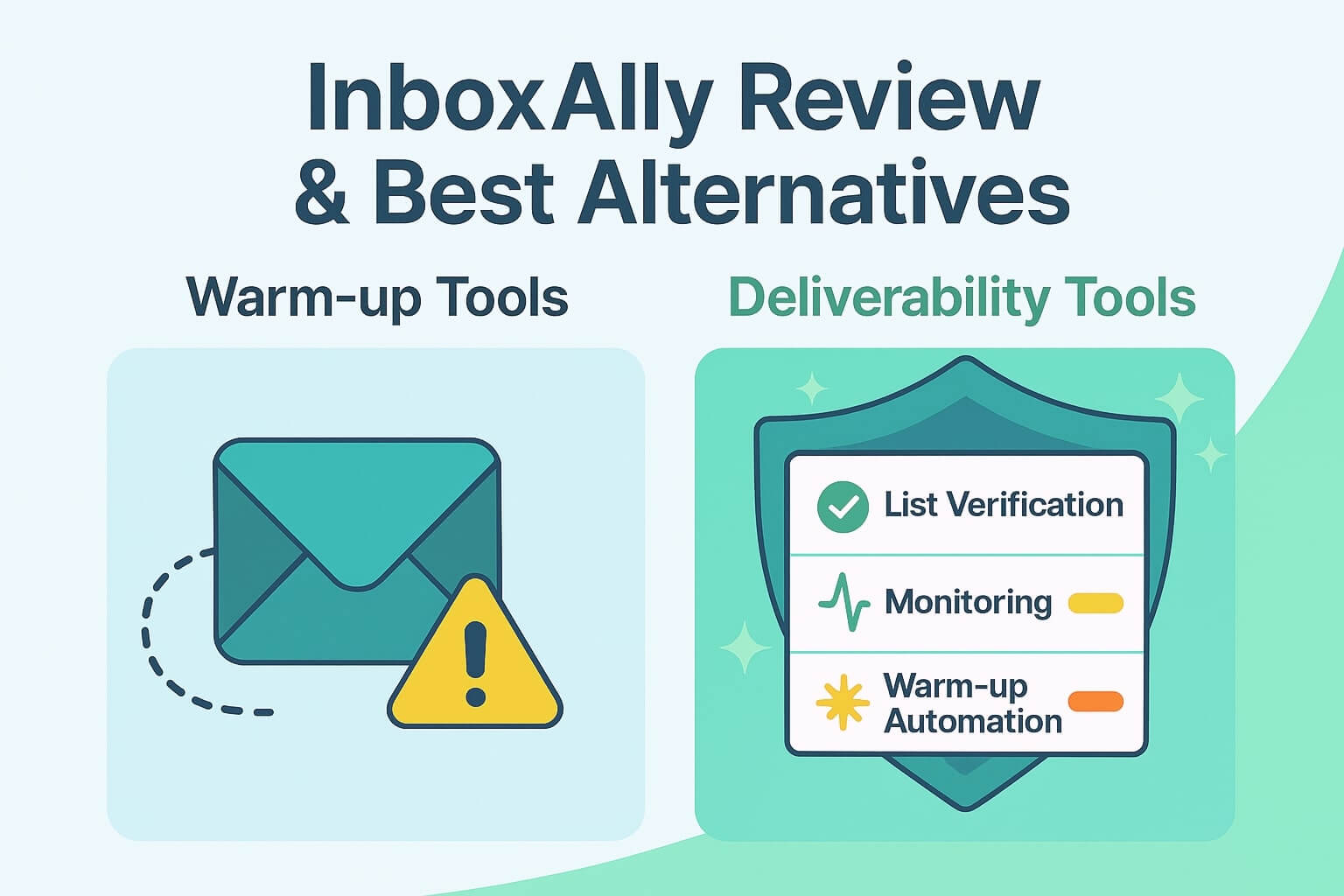BriteVerify is known for fast, simple email verification, making it a common choice for batch-cleaning lists or checking forms at the point of capture. But how does it perform for day-to-day deliverability, especially for B2B outbound teams?
We summarize what users report in reviews and public docs, then examine the practical pieces buyers care about: core checks (syntax, MX, SMTP), speed and ease of use, integrations and API, and pricing/TCO (including how credits work and expire). You’ll also see where BriteVerify fits best versus situations that need more prevention during live sends.
We'll also examine the practical limitations for teams running sequences at scale, particularly its handling of "catch-all" domains and lack of risk signals (like spam traps), so you can evaluate if it has the prevention capabilities you need.
TL;DR: BriteVerify reviews point to a fast, simple list cleaner that’s great for periodic hygiene and capture-time checks. It excels at core validation (syntax, MX, SMTP) and plugs easily into ESP/CRM stacks. The trade-offs show up in outbound: domain-level catch-all labels, limited risk intel, and a credit model with 1-year expiry can raise total cost for irregular usage. If you run daily B2B sequences, consider a platform that adds contact-level catch-all outcomes, spam-trap/complainer detection, inbox monitoring, hourly SPF/DKIM/DMARC checks, and native pre-send blocking in your SEP. Allegrow covers those prevention layers and offers an unlimited model for always-on hygiene.
What do users say about BriteVerify (most common themes from reviews)?
Across review sites, buyers describe BriteVerify as fast and straightforward. You upload a list or use the real-time API, it processes quickly, and results flow back into common ESPs/CRMs. Teams also like the low lift for non-technical users and the ability to buy bulk credit bundles—handy for periodic cleanups and capture-time checks.
Frustrations center on cost and verification depth. Pricing is credit-based and credits expire after one year, so irregular usage can raise overall spend versus subscriptions or non-expiring credits. Reviewers also note limited visibility into risky contacts—like spam traps or likely spam reporters—and that catch-all domains return “Accept-All” statuses. That keeps lists tidy but doesn’t tell an SDR whether a specific contact at a catch-all domain is safe for a live sequence or a hidden spam trap.
Net-net, BriteVerify does core validation well (syntax, MX, SMTP) and connects cleanly to ESP/CRM workflows, but it doesn’t emphasize prevention during live sends. If you run daily outbound with changing lists, you’ll usually want contact-level outcomes for catch-alls, risk signals, and pre-send blocking inside your sales engagement platform so risky contacts never go out. If your program relies on daily sequencing with shifting lists, shortlist tools that add those prevention layers.
BriteVerify: Features and limitations
Core validation (syntax, domain/MX, SMTP)
BriteVerify performs the fundamental checks required for list hygiene. This includes syntax validation (checking for typos and correct format like name@domain.com), domain/MX record checks (confirming the domain exists and has a mail server ready to accept mail), and basic SMTP pings (initiating a handshake with the server). These checks are effective at identifying and removing clearly invalid or non-existent email addresses, which forms the basis of any good list-cleaning process.
Catch-all handling
The primary challenge for B2B marketers surfaces here. When BriteVerify encounters a catch-all server, it returns an "Accept All" status. This identifies the domain as valid but provides no information about the specific contact. For outbound teams, this is an inconclusive result, forcing a choice: either risk sending to a potentially bad address (which could be a hidden spam trap) or suppress a large portion of the list, potentially losing high-value prospects.
Integrations & API
Connectivity is a strong suit. BriteVerify offers an API and a broad integration surface—most notably via Zapier templates and the BriteVerify for Salesforce app—so teams can verify lists or form inputs without leaving their stack. These connections, however, aren’t native pre-send controls inside sales engagement platforms, and they typically require some implementation effort. There’s no out-of-the-box, in-platform blocking at schedule/send like you’d see in SEP-native solutions.
Reporting & compliance
For list jobs, BriteVerify provides a results breakdown and exports so you can move cleansed data back into your ESP/CRM and maintain an audit trail. On compliance, Validity supplies a Data Processing Addendum and public GDPR guidance—helpful during vendor review and procurement.
Pricing & credits
Pricing is credit-based (“one credit per verification”) with visible pay-as-you-go bundles. That makes it easy to start small but can raise ongoing costs at scale. Importantly, Validity’s terms state that Verification Credit Blocks expire one year from purchase—a detail that matters for irregular usage. This model aligns well with periodic scrubs; teams running continuous outbound should consider unlimited-usage options.
BriteVerify vs leading alternatives (side-by-side)
Below is a pragmatic, features-first view of where BriteVerify sits versus common tools used by go-to-market B2B teams. It focuses on the capabilities that most affect sender reputation in high-stakes or high-volume B2B outbound: how deeply a tool verifies, how it treats catch-alls, whether it surfaces hidden risks (spam traps/likely complainers), and whether it can block risky sends inside your SEP before they go out.
Allegrow
Allegrow is built for prevention. Alongside syntax/MX/SMTP checks, it runs real-time health monitoring—hourly SPF, DKIM, and DMARC checks plus inbox placement visibility—so teams spot risk early and adjust before complaint rates threaten sender reputation.
The standout is blocking at the moment of send. Safety Net works inside Outreach, Salesloft, and HubSpot to block risky contacts as reps add or schedule them. For catch-alls, Allegrow returns contact-level “safe/unsafe” outcomes and surfaces hidden risks such as modern/recycled spam traps and likely manual spam reporters, giving ops clear go/no-go decisions instead of domain-level guesswork.
Operationally, Allegrow supports always-on hygiene with an unlimited model—verify at capture, re-verify on a schedule, and keep live cadences protected without rationing credits. For teams running daily B2B sequences on changing lists, this mix of monitoring, contact-level verdicts, and native pre-send blocking keeps reputation stable while preserving volume.
ZeroBounce
ZeroBounce combines verification (bulk/API) with a broader deliverability toolkit. In addition to syntax/MX/SMTP checks, it offers inbox placement testing and signals around abuse-prone or risky addresses, which helps marketing teams validate content/configuration before larger sends. It fits programs that want hygiene plus pre-send testing in one place.
Operationally, ZeroBounce is easiest to slot into ESP/CRM-centric workflows and periodic list work. Credits and bulk bundles make budgeting predictable, and teams with irregular usage often appreciate that purchased credits don’t expire. For outbound teams, note that its positioning centers on validation and testing—not on native pre-send blocking inside sales engagement platforms.
Where it lands: strong for campaign hygiene and pre-flight checks, especially when you want to sanity-check placement before scaling volume. If your priority is enforcing risk decisions inside Outreach/Salesloft/HubSpot or getting contact-level outcomes for catch-alls, you’ll likely pair ZeroBounce with additional workflow controls or consider a prevention-first platform.
NeverBounce
NeverBounce focuses on reliable validation for bulk jobs and real-time capture. Teams choose it for straightforward APIs, fast processing, and simple handoffs back into ESPs/CRMs—ideal for newsletters, permission-based lists, and steady list hygiene where existence checks do most of the work.
Its emphasis stays on validation rather than broader deliverability controls. You won’t find inbox placement monitoring, ongoing authentication checks, or native pre-send blocking for SEPs, so outbound programs that live in daily sequences usually layer other tools for prevention and enforcement.
Where it lands: a solid choice for list cleaning and capture-time verification with minimal friction. If your use case requires contact-level catch-all decisions, visibility into spam traps/likely complainers, or automated blocking at schedule/send, plan to augment NeverBounce or evaluate platforms designed for prevention during live sends.
When is BriteVerify the right fit?
BriteVerify makes sense when your priority is periodic list hygiene and capture-time checks, not day-to-day outbound risk prevention. Teams that upload lists quarterly or gate forms with an API tend to value the simple workflows, quick turnarounds, and no-code connectivity via Zapier and Salesforce—making it easy to clean data and push results back into ESP/CRM systems.
It also fits ESP-centric marketing programs and SMB volumes where core validation (syntax, MX, SMTP) is enough to keep bounces under control. Review patterns consistently highlight ease of use and speed, which align with one-off list scrubs and capture-time verification more than with daily sequencing inside a sales engagement platform.
Budgeting is predictable for short, bounded jobs: the credit-based model lets you buy exactly what you need. Just account for credits expiring after one year, which can raise overall cost for irregular usage or sporadic testing cycles. If you’re maintaining complaint rates below the ~0.3% guardrail, batch hygiene plus capture-time checks can be sufficient—provided your lists aren’t heavy on catch-all domains and your motions don’t depend on complex outbound cadences.
When should you consider an alternative?
Pick an alternative when your program runs daily outbound with changing lists and you need to prevent risk—not clean it up later. In that motion, list scrubs alone don’t stop live bounces or complaints; you need tools that block risky contacts before send, surface real-time placement/auth issues, and give ops immediate feedback as sequences run.
Shortlist alternatives if catch-all domains are common in your ICP. Domain-level labels like “accept-all/unknown” keep lists tidy but don’t answer the SDR’s real question: can I safely sequence this contact today? Look for contact-level safe/unsafe outcomes on catch-alls and signals for likely spam traps or manual complainers so you can automate go/no-go decisions rather than guess.
If your teams live inside Outreach, Salesloft, or HubSpot, prioritize native pre-send blocking that enforces rules at schedule/send—so risky records never leave the platform. Pair that with inbox placement visibility and ongoing SPF/DKIM/DMARC checks to catch configuration drift and content issues before they scale.
Finally, check the economics. Credit models suit one-off cleans, but credits that expire after a year can drive up cost for irregular usage. If you verify continuously—at capture, ahead of each push, and on rolling re-verification—an unlimited model avoids rationing and aligns spend with always-on hygiene.
Summary & next steps
BriteVerify is a good fit when you need fast, straightforward list hygiene and capture-time checks, not day-to-day outbound risk prevention. It handles core validation well and plugs neatly into ESP/CRM workflows. Where outbound teams usually need more is contact-level decisions for catch-alls, clearer risk signals (e.g., likely spam traps/manual complainers), inbox monitoring, and native pre-send blocking to keep bounces and complaints from hitting live sequences.
If you’re deciding between approaches, run a simple pilot: clean a representative list with BriteVerify, then run the same list through a prevention-focused workflow that adds contact-level catch-all verdicts and pre-send enforcement. Track four outcomes before and after—hard bounces, user-reported spam, inbox placement (or a solid proxy), and reply rate. The option that reduces risk and preserves volume is the one that protects pipeline, not just lists.
Want a low-friction way to test this? Start a 14-Day Free Audit with Allegrow. Analyze a pilot list of up to 1,000 contacts, surface hidden risks, and return a clean suppression file so you can choose with confidence.





